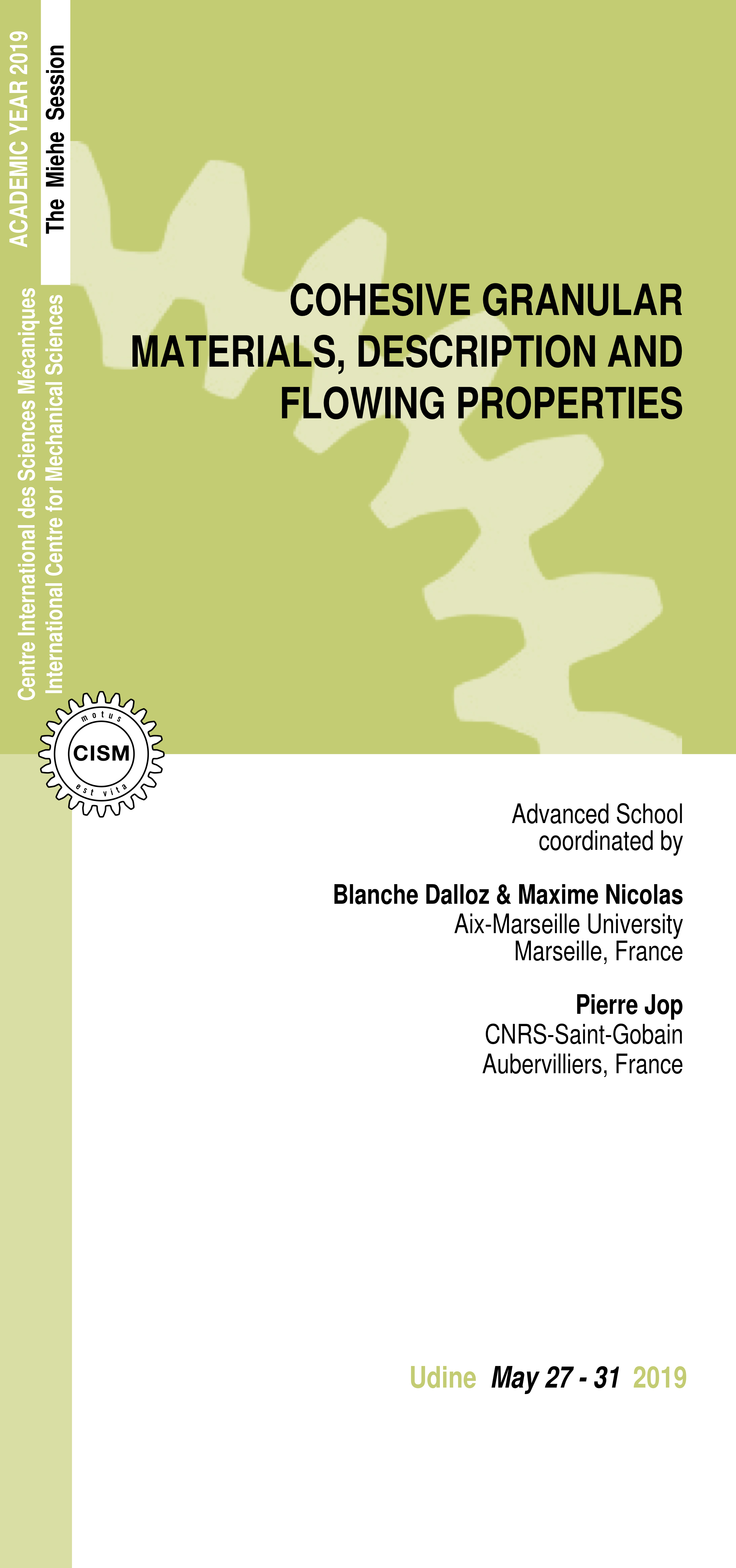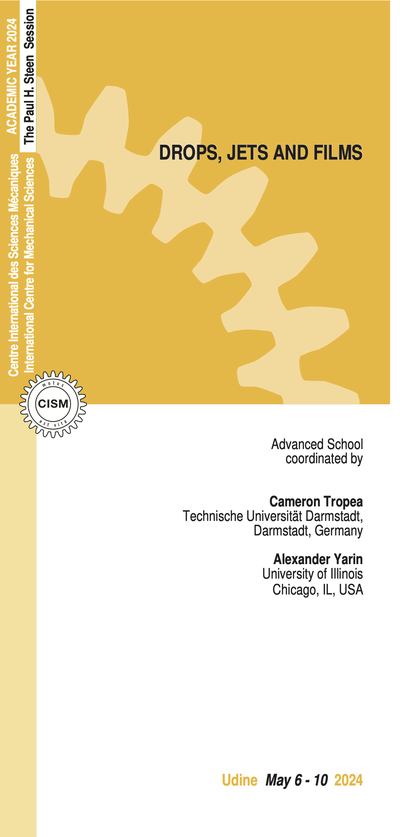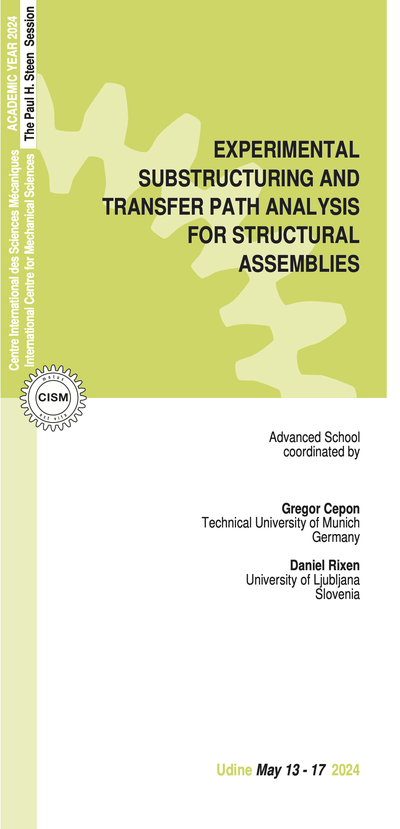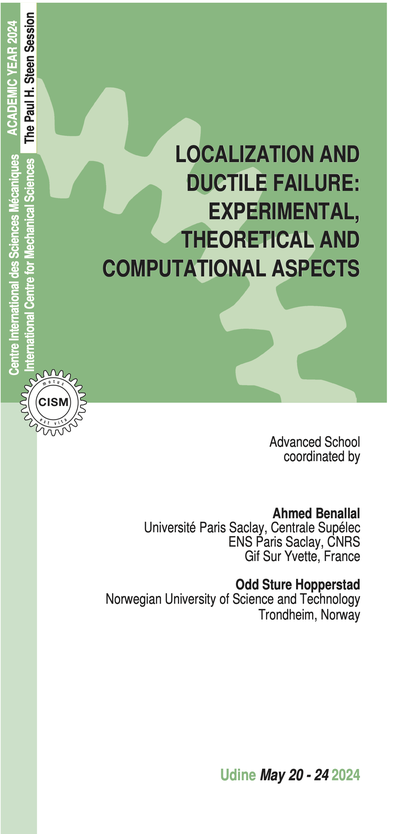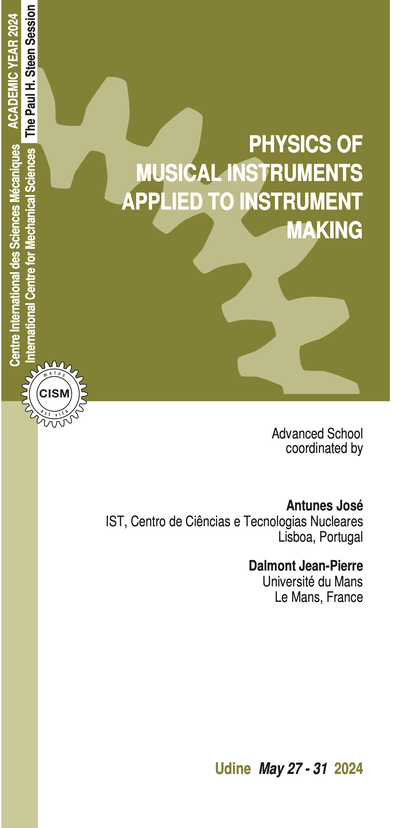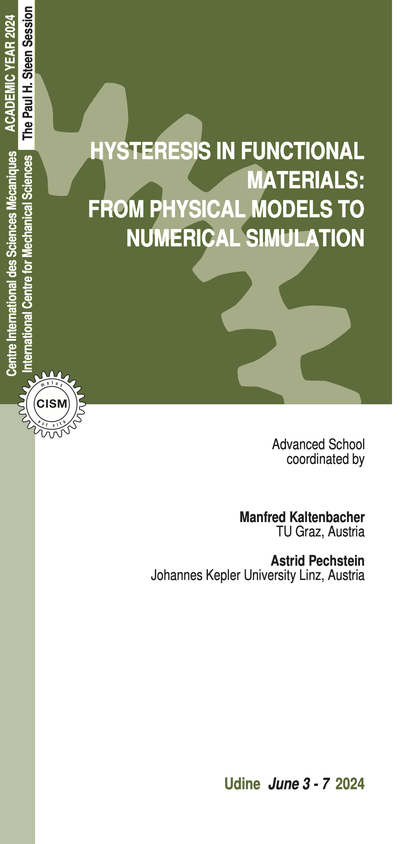Granular matter and powders are widely used in the manufacturing of numerous products and in many industries. Despite this intense utilization, their behavior and rheological properties are non-trivial. One major difficulty is that powders and their ability to flow are strongly affected by cohesive effects. In worst cases, the flow may stop and is somehow difficult to start again. The main objective of this course is to provide an overview of the knowledges on cohesive powders from the academic and industrial point of view. The course will cover three different scales.
At the particle scale, the particle motion is mainly governed by friction, particle-to-particle cohesion, interaction with walls. The physical origins of the cohesion (Van der Waals, electrostatic or magnetic forces, capillary forces, chemical forces, polymer layers) will be presented in detail. Two courses will be devoted to this topic. The effects of the cohesion driven by humidity on powders will be discussed in detail in one course, both from an experimental and numerical point of views. Physico-chemical aspects and adhesion mediated by soft media will also be covered by a specific series of lectures.
At a larger scale, where many particles interact, discrete or continuous models may be depicted. A numerical technique such as the DEM may be very useful to have a close insight on coarse-grained particle volume fraction, velocity, forces and stresses in a lab-scale volume containing cohesive particles. On the other hand, experiments with rheometers, inclined planes, rotating drums, hoppers, piles can provide useful elements to build an elementary continuous model. Three series of lectures will develop the techniques to prepare a cohesive granular material and the principal ways to study the static properties and the flow behavior of cohesive material.
At last, at an even larger scale, the course will present issues and solutions occurring in large volume systems such as silos, hoppers, transporting ducts, and other industrial equipment dealing with a large quantity of material. A series of lectures will focus on handling operations and will discuss how the powder rheology may bring useful facts about the industrial processes.
One of the key feature of this course is to propose to attendees a wide scope on the subject, from contact interaction theory to commercially available apparatus (powder rheometers).
The lectures are mainly designed for doctoral students of applied physics, mechanics, engineering and chemical engineering with a strong research interest in theoretical modeling, numerical simulation and experimental. They are also suited for young and senior researchers working in academia or in private research and development centers, interested in gaining a compact yet comprehensive overview of cohesive powders from its fundamental physical background, to the computational methods and the experimental techniques available for measuring the flow properties of such powders.
Andreotti B., Forterre Y., Pouliquen O. (2013) Granular Media; Between Fluid and Solid, Cambridge University Press.
Schulze D. (2008) Flow properties of bulk solids. In: Powders and Bulk Solids. Springer, Berlin, Heidelberg.
Lumay G. (2012) Measuring the flowing properties of powders and grains, Powder Technology 224, 19–27.
Fayed M., Otten L. (1997) Handbook of Powder Science & Technology, Springer US.
Samdani A. & Kudrolli A. (2001) Angle of repose and segregation in cohesive granular matter. Phys. Rev. E 64, 051301.
Castellanos A. (2005) The relationship between attractive interparticle forces and bulk behaviour in dry and uncharged fine powders. Advances in Physics, Vol. 54, No. 4, p. 263–376.
Bocquet L., Charlaix E., Restagno F. (2002) Physics of humid granular media, C. R. Physique 3, p.207–215.
Alarcon H., Géminard J.-C., Melo F. (2010) The effect of cohesion and shear modulus on the stability of a stretched granular layer. Phys. Rev. Lett. 105, 208001.
Jarray A., Magnanimo V., Ramaioli M., Luding S. (2017), Scaling of wet granular flows in a rotating drum, EPJ Web of Conferences, 140, 03078.
Imole O.I., Paulick M., Morgeneyer M, MagnanimoV, Chavez Montes B.E., Ramaioli M., Kwade A., Luding S. (2015) Slow stress relaxation behavior of cohesive powders, Powder Technology, 293, p. 82-93.
Cyprien Gay C., da Silveira R. (2004) Anisotropic elastic theory of preloaded granular media.Europhys. Lett., 68(1) p. 51-57.
Mathonnet J.-E., Sornay P., Nicolas M., Dalloz-Dubrujeaud B., (2017) Compaction of non-cohesive and cohesive granular materials under vibrations: experiments and stochastic model. Phys. Rev. E 95 042904.
with Maxime Nicolas
5 lectures on: Introduction: cohesive powders in the natural and industrial worlds. Basics on granular materials: an overview on statics, flow and rheology. Experimental techniques for cohesion-controlled particles. The inclined plane as a cohesion stress measurement tool. Introduction to DEM simulations with LIGGGHTS.
6 lectures on: basics of isotropic elasticity; adhesion; introduction to capillarity; introduction to adhesion mediated by soft media; interactions between grains embedded in soft matrix; Shear forces; introduction to more detailed kinematics (grain rotation, micropolar media); Soft "granular media" (bubbles, bubbly liquids, liquid foams, wet liquid foams); biological tissues.
6 lectures on: Several aspects inspired by industrial applications involving cohesive particles will be discussed. Flows of particles that can melt (sintering in rotary kiln, flow evolution with time), compression of powders (flow rules, evolution of the structure), mixing issues for grains and liquids (spreading of the liquid, control of the segregation), granulation processes (energy balance, wet granulation).
6 lectures on: Effect of the cohesive forces on the powder behaviour (experimental approach). Effect on the packing; Effect of cohesive forces on the flowing properties. The rotating drum and the cohesiveness. Combined effects of capillary and electrostatic forces. Role of typical additives (fumed silica, mesoporous silica, stearate, …) on the different cohesive forces.
with Blanche Dalloz
5 lectures on: Introduction: cohesive powders in the natural and industrial worlds. Basics on granular materials: an overview on statics, flow and rheology. Experimental techniques for cohesion-controlled particles. The inclined plane as a cohesion stress measurement tool. Introduction to DEM simulations with LIGGGHTS.
6 lectures on: Origins and motivations in powder flow properties characterization in terms of shear testing for industrial purposes. Strengths and limits for shear testing. Direct and indirect shear testers: the different shear testing. Static and dynamic testers for powder flow properties. Shear testing under process conditions. Some examples of use of powder shear testers to estimate interparticle cohesive forces. Examples shear testing results to estimate the natural agglomeration of cohesive powders in aerated discharge and fluidization. The use of powder rheometers with fine and cohesive powders and their relations with shear testing results: the impor- tance of the rheometer geometry. Potential of powder rheometers in modern applications.
6 lectures on: moisture transfer and cohesion in amorphous materials. Sorption isotherms, water diffusion, glass transition: effect on mechanical properties. Sintering and caking of powders : effect on flow properties. Industrial applications relevant to pharma and food: dosing of cohesive powders, dispersing powders in a liquid, texturisation processes to improve flow properties.
The registration fee is 600.00 Euro + VAT*, where applicable (bank charges are not included). The registration fee includes a complimentary bag, four fixed menu buffet lunches (on Friday upon request), hot beverages, downloadable lecture notes and wi-fi internet access.
Applicants must apply at least one month before the beginning of the course. Application forms should be sent on-line through the following web site: http://www.cism.it. A message of confirmation will be sent to accepted participants. Applicants requiring assistance with the registration should contact the secretariat at the following email address cism@cism.it.
Applicants may cancel their course registration and receive a full refund by notifying CISM Secretariat in writing (by email to cism@cism.it) no later than two weeks prior to the start of the course.
Cancellation requests received during the two weeks prior to the start of the course will be charged a 50.00 Euro handling fee. Incorrect payments are also subject to a 50.00 Euro handling fee.
A limited number of participants from universities and research centres who are not supported by their own institutions can be offered lodging and/or board, if available, in a reasonably priced hotel or student guest house.
Requests should be sent to CISM Secretariat by March 27, 2019 along with the applicant's curriculum and a letter of recommendation by the head of the department or a supervisor confirming that the institute cannot provide funding. Preference will be given to applicants from countries that sponsor CISM.
Information about travel and accommodation is available on the web site www.cism.it, or can be mailed upon request.
* Italian VAT is 22%.
